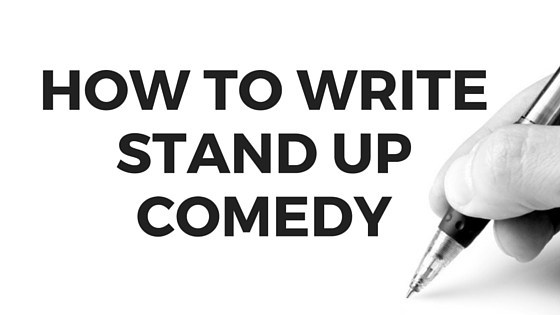You ever sit down to write jokes and nothing comes out? Every comedian hits that wall, even pros. The blank page doesn’t care how funny you were last night or how many TikTok views you got. That’s exactly why stand-up comedy exercises are so valuable. They give you structured ways to beat writer’s block and start writing punchlines fast.
What Makes a Good Writing Exercise?


For new comedians, a good writing exercise drops you straight into the comedic tension. It gives you direction without forcing you to write any specific jokes or lose your comedic voice.
Many comedy writing exercises don’t do this. Most comedy writing exercises out there feel like busywork. They tell you to free write for twenty minutes or to stare at a banana until it speaks to you. That does not create jokes, it just makes you hungry and confused.
Many simply ask you to start with a random noun and then simply start writing. The problem with them is that they don’t give you any direction. You end up with a random noun, like a lampshade, and wonder what’s funny about it. If this has happened to you, know that it’s not your fault… it was just a bad exercise.
Why These Stand-Up Comedy Exercises Are Different
These exercises are different. Not gimmicks, not magic formulas, just structured writing drills that force your brain to play instead of panic. So if you want to learn how to write stand-up comedy or you’re worried you’re not funny enough to be a comedian, don’t wait for inspiration! Use these drills to get writing fast. Getting reps in quickly is the best way to learn how to be a comedian.
These exercises actually work because they are built to get you laughing and writing in just a few minutes. These exercises start with the comedic tension already in place, so finding punchlines becomes quick and fun. You do not have to cluelessly wander around for something funny. There’s no racking your brain while asking yourself, “What’s funny about a lampshade?” The comedic tension is baked into the setup, and your only job is to play with it until the laugh shows up.
In this post, I’ll share five proven comedy writing drills you can try today. Each one is quick, simple, and designed to get you writing jokes and stories you can actually use on stage. And if you want to go deeper, you can grab my free PDF with all 12 stand-up comedy writing exercises. You’ll get advanced punchline drills, delivery tweaks, and a 7-day habit challenge.
Why These Stand-Up Comedy Exercises Actually Work
I optimized these exercises for beginners learning how to do stand-up comedy (but even veterans can use them to sharpen their material):
They create quick wins. Each exercise is designed to get you from blank page to funny idea in under five minutes. When you leave with a laugh on the page, you want to come back tomorrow.
They start with comedic tension. Every drill drops you into a situation that already feels off or wrong. This makes it easy to write funny punchlines. Because the tension is built in, punchlines pop out faster and with less effort.
They turn real life into material. Instead of forcing formulas, these drills use the weird stuff you already notice every day. Your mom on social media, your boss at work, your own attempts at being healthy. If it feels off or wrong, it can become comedy.
They build into a system. There are exercises for each stage of the comedy writing process. In the downloadable PDF, you’ll find exercises for getting started when you’re facing a blank page, creating comedic tension and joke premises, using comedic tension to create hilarious punchlines, and even exercises for setting up jokes and stories for maximum laughter. These are not random prompts. Each step feeds the next so you always know what to do with the raw material you create.
They keep it fun. You will actually laugh while you write. That means you do the work more often and the habit sticks.
You don’t need to believe me. Try the first exercise and you will feel it. You will write something that makes you laugh right now, and that is the whole point.
Stand-Up Comedy Exercises To Get Laughs Quickly
Exercise 1: But Statements
This is easily my favorite stand-up comedy writing exercise. Creating But Statements in your material is incredibly easy and often leads to really funny situations that are ripe for funny punchlines.
But Statements follow a simple pattern: the left side gives the context or situation, followed by “but,” and the right side introduces a believable problem.
A But Statement is an easy way to set up comedic jokes or stories. With a single sentence, you can tell the audience the situation as well as what problems you were having. That gets the audience instantly curious and engaged.
Instructions
In this exercise, you’ll start with a situation with comedic tension. Each But Statement gives a context and implies some type of problem. Choose your favorite and then spend 3-5 minutes writing a story. Think about what each person might say and how you’d respond.
- I tried to compliment her outfit, but I said the wrong thing.
- I went to Whole Foods, but I couldn’t pronounce “quinoa.”
- The mechanic tried to explain the problem, but I had no idea what he was talking about.
- I want to have my own life, but my mom follows me on social media.
- I was trying to be taken seriously on a Zoom call, but my cat kept interrupting.
- I’m on a first date, but I like using coupons.
- I went to an amusement park, but I’m easily frightened.
- I want to eat healthier, but I have no idea how to read the labels.
Exercise 2: Create Your Own But Statements (For Comedic Storytelling or Joke Writing)
In the first exercise, we used comedic tension as a stepping stone to write funny punchlines. Now, let’s learn how to write stand-up comedy jokes from the beginning. To do this, we’ll learn how to create comedic tension ourselves.
But Statements are incredibly easy to create and often lead straight into funny stories. Now that you’ve had some practice with pre-written examples, it’s time to make your own.
Start by writing the setup for a joke. This can be an experience, observation, or opinion. Next, add “but” to the end. The result might look like: “I wanted to compliment her dress, but…” Finally, finish it with a realistic problem, such as “I’m shy,” “I always trip over my words,” or “I always make things about me.” How you finish the But Statement will shape the type of joke you write and your eventual punchline.
Instructions
- Spend 3–5 minutes coming up with 10 But Statements.
- The left side tells the audience what was happening (the setup).
- The right side introduces a (realistic) problem.
Together, they should form one sentence that creates instant comedic tension.
It might be helpful to use a formula like these:
- “I wanted to , but .”
- “It’s easy for some people to ______ , but .”
- “I was thinking about , but .”
Exercise 3: Mismatch


One of the fastest ways to learn how to write stand-up comedy is to practice mismatches. Comedy often comes from putting the wrong person in the wrong place. In this exercise, we’ll create a mismatch between a character and a situation. For example, imagine a really loud person in a library. It creates instantly comedic tension because the person doesn’t match the situation. Your audience will instantly see that things are going to go wrong (creating comedic tension), and they’ll have to wait for your punchline to figure out exactly how. Your punchline can then release that built-up tension for big laughs.
Choose your favorite prompt from the list below. Spend 3–5 minutes writing a short story. Start by thinking about any weird, inappropriate, or wrong things that could happen (while still being believable), then write as if it actually did.
You can set it up as a hypothetical (“Wouldn’t it be weird if…”) or as a “real” story (“I was once…,” “A few months ago…,” “I heard that…,” etc.). I’ve added a few joke premises for the first prompt to get you started.
Example: A grandma at a rap battle.
Joke Premises
- She takes out her hearing aids when she’s ready to fight.
- She’s way too comfortable with slang.
- She’s already got a rap name. She goes by “M.C. __”
Writing Prompts
- A grandma at a rap battle
- A cheap person at a fancy restaurant
- A magician at a traffic stop
- A people-pleaser in a debate
- A narcissist in a support group
- An angry customer at a self-checkout machine
- An easily frightened person at a haunted house
- A vegan at a BBQ
- A sleepwalker in a 5K race
Exercise 4: Visiting The World’s Dumbest Museum
In this comedy writing exercise, we’ll take a bizarre (but real) thing and comment on it. Just like with But Statements, this creates instantly comedic tension that we can explore to write funny punchlines. This is a great way to practice writing when you’re uninspired or if you’re just learning how to write stand-up comedy and don’t have a reservoir of potential ideas to explore.
Search the internet for the worst/dumbest museums and choose your favorite. Imagine what you’d see there, what personal stories a tour guide would tell, what the gift shop would sell, etc. Here’s a list to get you started: Toilet Museum, Museum of Barbed Wire, Instant Noodles Museum, or the Salt & Pepper Shaker Museum.
- Imagine what it’d be like to go there.
- Imagine what it’d be like to be a tour guide there.
Exercise 5: “Hey, That’s Not Right” Comedy Journal


At the heart of every joke or comedic story is something that feels a bit off, weird, wrong, or inappropriate. These moments can be used to set up comedic tension for a longer story, as a setup that leads directly to the punchline, or as the punchline itself. That’s why this writing exercise is so important: It gives you an entry-point to writing stand-up comedy.
To learn more about why this works so well, check out our free article “Comedic Conflict: The Mechanics of Comedy.” It’ll show you the science behind “Hey, that’s not right” moments.
Instead of starting with random words and then trying to think of an interesting angle on it, why not skip that step and start with the part of the comedic story or joke that audiences actually want? Don’t try to take random nouns and think of something weird or odd about it. Start with something you noticed in real life that you already think is weird or odd, and start from there.
Steps
Write down 5-10 things that make you pause and think, “Hey, that’s not right.” They can be experiences, observations, or opinions that range from significant problems to tiny thoughts that pop up in your head and quickly pass.
Spend a few minutes writing your list now, but know that this is best done throughout the day/week. You’re looking for anything that feels off, weird, or inappropriate.
- For each idea, think about how your favorite comedians might use it in their material.
- Next, ask yourself, “What’s a playfully inappropriate way to respond?”
- For the next 7 days, write down at least one “Hey, that’s not right” moment that you noticed. When you’re done, think about playful ways to respond to it. Don’t wait for the perfect answer. Train yourself to find odd moments in everyday life now so you’ll be ready when the best opportunities arise.
| “Hey, that’s not right” moment. | A playful way to respond | |
| Day 1 | ||
| Day 2 | ||
| Day 3 | ||
| Day 4 | ||
| Day 5 | ||
| Day 6 | ||
| Day 7 |
Want All 12 Stand-Up Comedy Exercises in a Free PDF?
Writer’s block doesn’t have to kill your comedy. These five comedy writing exercises will get you started, but the real growth comes when you build consistency. That’s why I created a free comedy writing workbook with 12 exercises.
Inside, you’ll get advanced punchline drills, delivery tweaks, and a 7-day habit challenge that keeps you writing daily. Open it, do one drill, and you’ll walk away with something funny. If you are serious about learning how to be a comedian, this free PDF is for you.
These exercises will get you unstuck and give you fresh material today, but I kept the deeper drills for the free PDF workbook. In the free PDF, you’ll get 10 stand-up comedy writing exercises and 2 performance exercises.
Inside the PDF you will find all twelve comedy writing exercises, including:
- My all-time-favorite stand-up comedy writing exercise that makes it unfairly easy to create funny punchlines in any situation.
- 2 performance exercises that make your timing and delivery sharper on stage.
- A unique way to brainstorm stand-up comedy topics.
I built the workbook so you can open it, do one drill, and walk away with something funny every single time. It is like having a personal trainer for your comedy brain.
Get the full printable workbook with all twelve drills, including advanced punchline practice, delivery tweaks, and a seven-day habit challenge. Open it, do one drill, and walk away with something funny every time.

